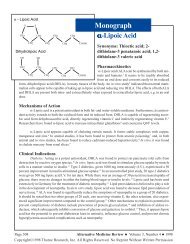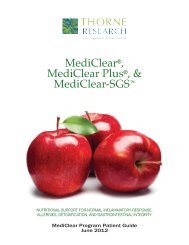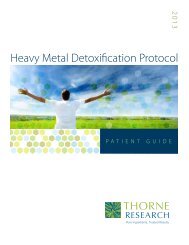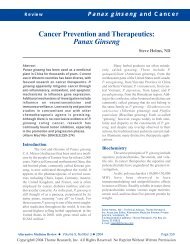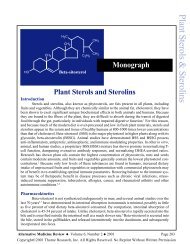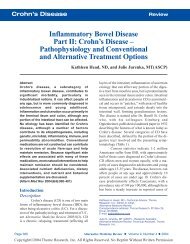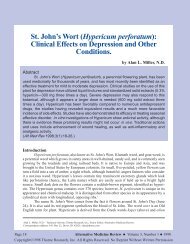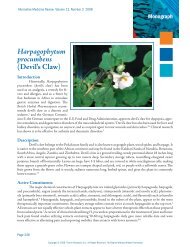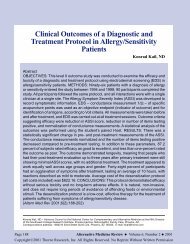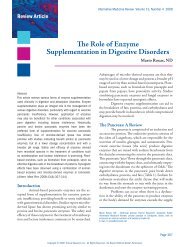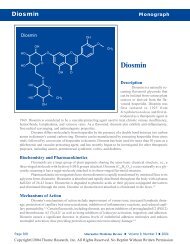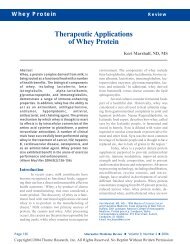Create successful ePaper yourself
Turn your PDF publications into a flip-book with our unique Google optimized e-Paper software.
<strong>Wound</strong> <strong>Healing</strong> Review<br />
three times daily for three days after surgery and,<br />
subsequently, two tablets three times daily for two<br />
weeks. On the fourteenth post-operative day the<br />
limb volume of the treatment group was reduced<br />
by 17 percent compared with nine percent in the<br />
control group. The total number of analgesics consumed<br />
by the treatment group was also significantly<br />
reduced in comparison to the control<br />
group. 65<br />
Studies by Tassman et al show bromelain<br />
reduced swelling, bruising, pain, and healing time<br />
in patients following dental surgeries. 63,66 In a<br />
double-blind study of dental surgery patients, bromelain<br />
was found to decrease swelling to 3.8 days,<br />
compared with seven days in patients given placebo.<br />
In addition, duration of pain was reduced to<br />
five days in the treatment group, compared to eight<br />
days in the placebo group. 63<br />
In an uncontrolled trial, bromelain was<br />
reported to positively influence swelling, pain at<br />
rest and during movement, and tenderness in patients<br />
with blunt injuries to the musculoskeletal<br />
system. 67 Although bromelain has been shown to<br />
reduce post-operative and trauma-related pain, this<br />
is probably related to its anti-inflammatory action<br />
rather than a direct analgesic effect. 68<br />
Aside from its documented anti-inflammatory<br />
activity, bromelain is of interest to surgeons<br />
because of its ability to increase resorption rate of<br />
hematomas. Bromelain’s influence on hematoma<br />
resorption was demonstrated using artificially induced<br />
hematomas in humans. Hematomas in the<br />
treatment group resolved significantly faster than<br />
controls when oral bromelain was given at the time<br />
of hematoma induction and for seven days thereafter.<br />
69<br />
Seltzer investigated two different doses of<br />
bromelain in patients undergoing rhinoplasty.<br />
Fifty-three patients were randomized to receive<br />
either one of two doses of bromelain or placebo.<br />
In patients receiving placebo, swelling and ecchymosis<br />
persisted for seven days, compared to two<br />
days in both bromelain groups. 70 However, a randomized<br />
trial of 154 facial plastic surgery patients<br />
receiving either 400 mg bromelain daily or placebo<br />
for one day before and four days after surgery<br />
found no statistically significant differences<br />
in edema between the two groups. 71<br />
Tassman et al noted that, while post-surgical<br />
oral bromelain administration was effective<br />
in reducing pain, swelling, and healing time, a<br />
protocol using pre- and post-surgical bromelain<br />
is recommended. 63 Studies have shown bromelain<br />
prevents aggregation of blood platelets in patients<br />
with high platelet aggregation values, which has<br />
led to recommendations by physicians and surgeons<br />
to avoid oral bromelain prior to any surgical<br />
procedure. In one human trial, bromelain was<br />
administered orally to 20 volunteers with a history<br />
of heart attack or stroke, or with high platelet<br />
aggregation values. Bromelain decreased platelet<br />
aggregation in 17 of the subjects and normalized<br />
values in eight of the nine subjects who previously<br />
had high aggregation values. 72 Contrary to this,<br />
other human studies have shown oral bromelain<br />
to be free of any significant effects on clotting<br />
parameters. 73,74 In one study, 47 patients with various<br />
disorders leading to edema and inflammation<br />
found no significant effects of oral bromelain (40<br />
mg four times daily for one week) on bleeding,<br />
coagulation, and prothrombin time.<br />
It is noteworthy that the studies pertaining<br />
to bromelain and platelet aggregation are over<br />
30 years old. The potential benefit of pre- and postsurgical<br />
oral bromelain on hematoma resorption,<br />
pain, inflammation, and healing time justifies the<br />
need for concise, well-designed clinical trials<br />
evaluating different doses of bromelain on clotting<br />
parameters. Until further data is available regarding<br />
bromelain’s action on platelets, oral bromelain<br />
administration should be withheld or used<br />
with caution before surgery.<br />
Glucosamine<br />
Hyaluronic acid is an important part of<br />
the extracellular matrix and one of the main glycosaminoglycans<br />
secreted during tissue repair.<br />
Production of hyaluronic acid by fibroblasts during<br />
the proliferative stage of wound healing stimulates<br />
the migration and mitosis of fibroblasts and<br />
epithelial cells. Glucosamine appears to be the<br />
rate-limiting substrate for hyaluronic acid synthesis.<br />
75 In vitro studies suggest the mechanism of<br />
glucosamine on repair processes involves stimulation<br />
of the synthesis of glycosaminoglycans and<br />
Page 366 Alternative Medicine Review ◆ Volume 8, Number 4 ◆ 2003



